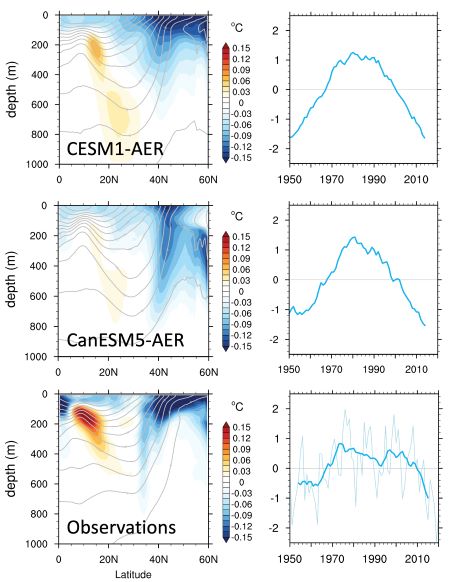Subsurface ocean temperature responses to the anthropogenic aerosol forcing in the North Pacific
Shi, J.-R., Y.-O. Kwon, and S. E. Wijffels, 2023. Subsurface ocean temperature responses to the anthropogenic aerosol forcing in the North Pacific. Geophys. Res. Lett. 50, e2022GL101035, https://doi.org/10.1029/2022GL101035

Top two rows: Forced patterns and corresponding time series of North Pacific temperature responses to the anthropogenic aerosol forcing from CESM1 and CanESM5 large-ensemble simulations. Bottom row: Extracted pattern and time series from observations based on the Signal-to-noise-maximizing Pattern Filtering method. [Figure is adapted from Shi et al. 2023.] Figure provided by J.R. Shi.
The North Pacific has attracted much attention recently in terms of the effect of anthropogenic aerosols. A recent study from Jia-Rui Shi, Young-Oh Kwon, and Susan Wijffels focuses on separating the subsurface patterns of the aerosol-induced ocean temperature responses in the North Pacific from its strong internal variability. Applying the pattern recognition method to large-ensemble simulations from two models, Shi et al. (2023) find that aerosols from extratropical regions govern a nonmonotonic feature in North Pacific temperature change, which reversed around the year 1985. Moreover, along with this temporal feature, aerosols can induce a characteristic zonal-mean pattern: a substantial temperature change in the North Pacific subpolar regions and a reversed change on the southern flank of the subtropical gyre. Furthermore, this aerosol-induced pattern is distinct from the pattern associated with internal variability. Importantly, this nonmonotonic temporal feature and zonal-mean pattern are supported by historical ocean observations, indicating the non-negligible effect of anthropogenic aerosols in recent climate change.
